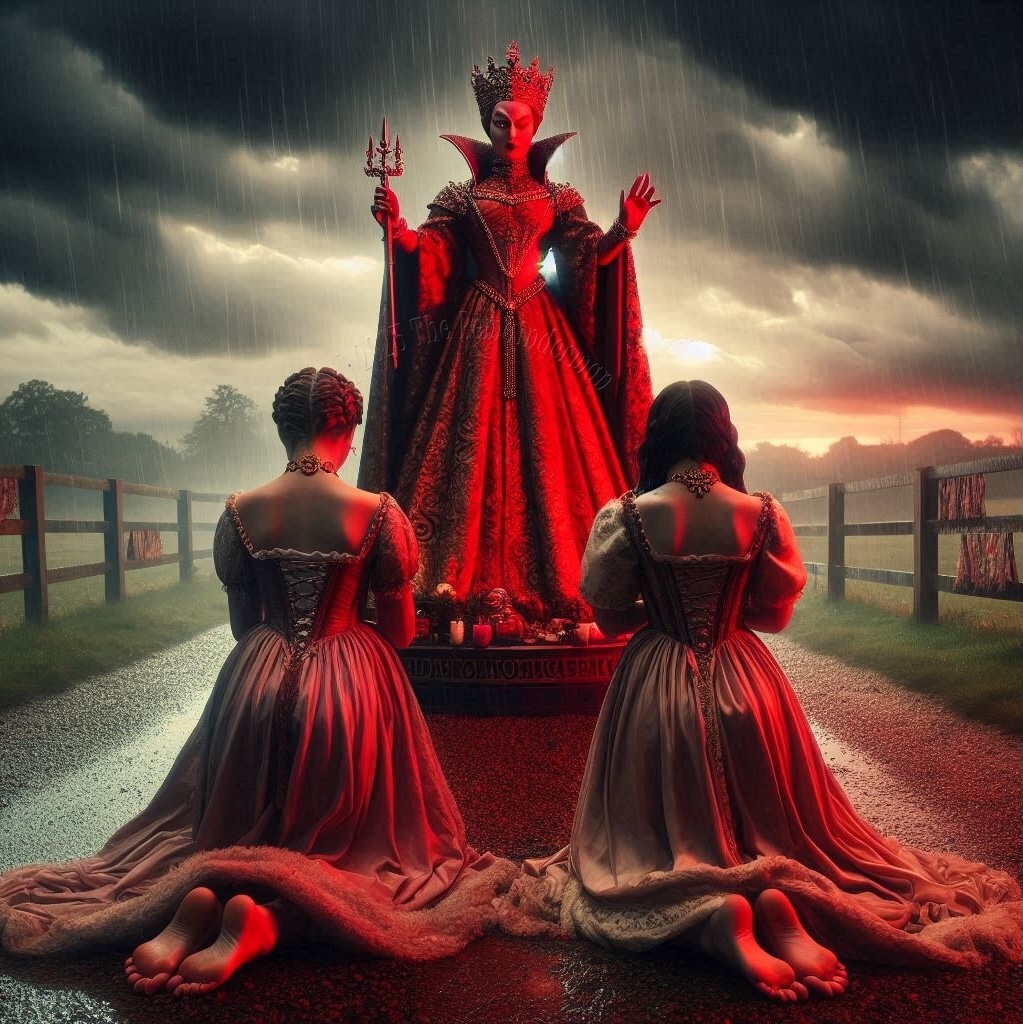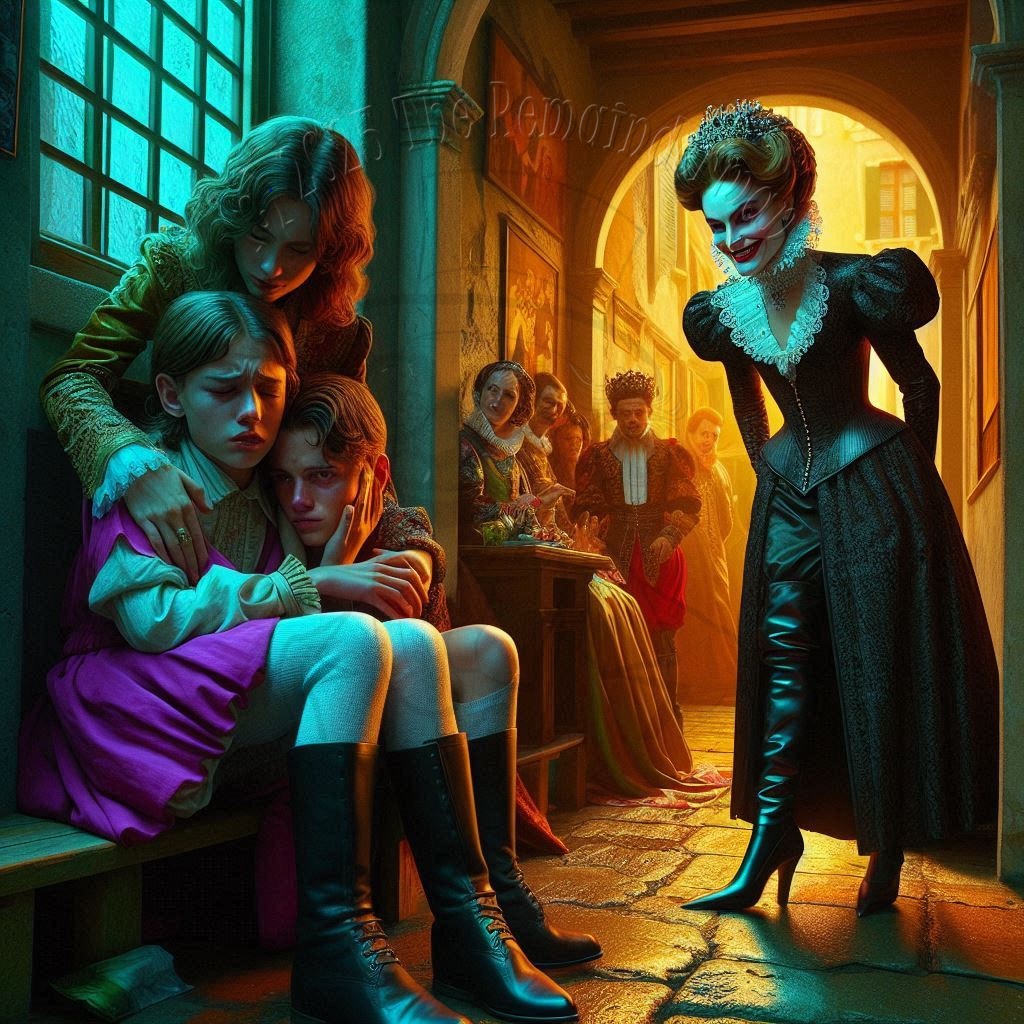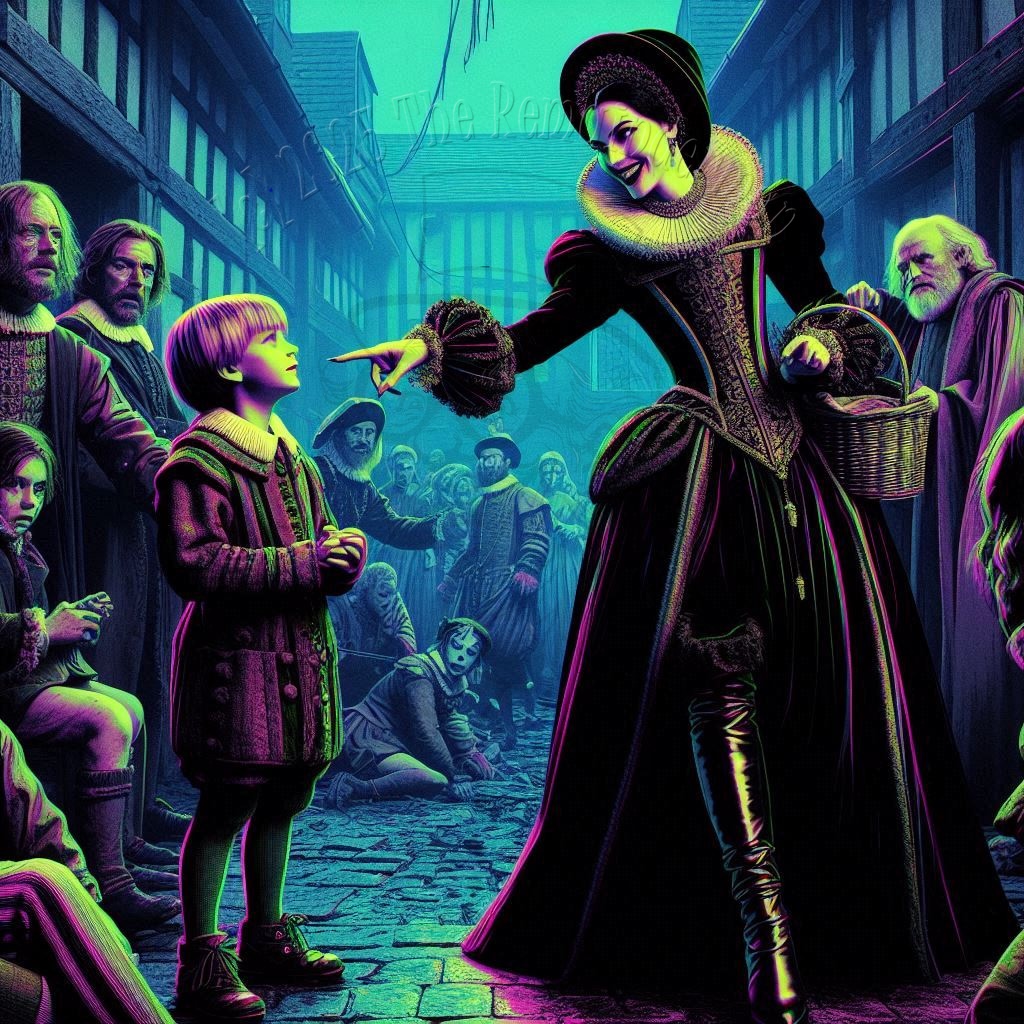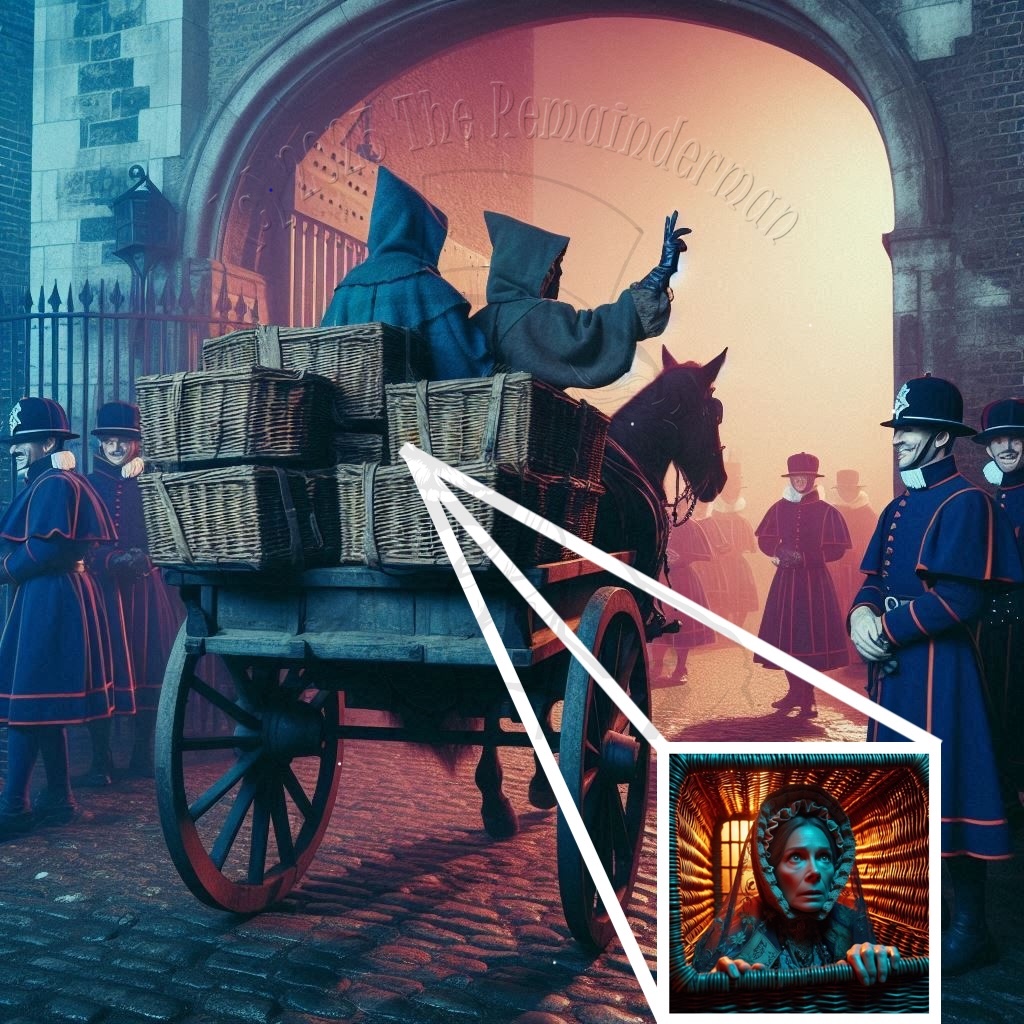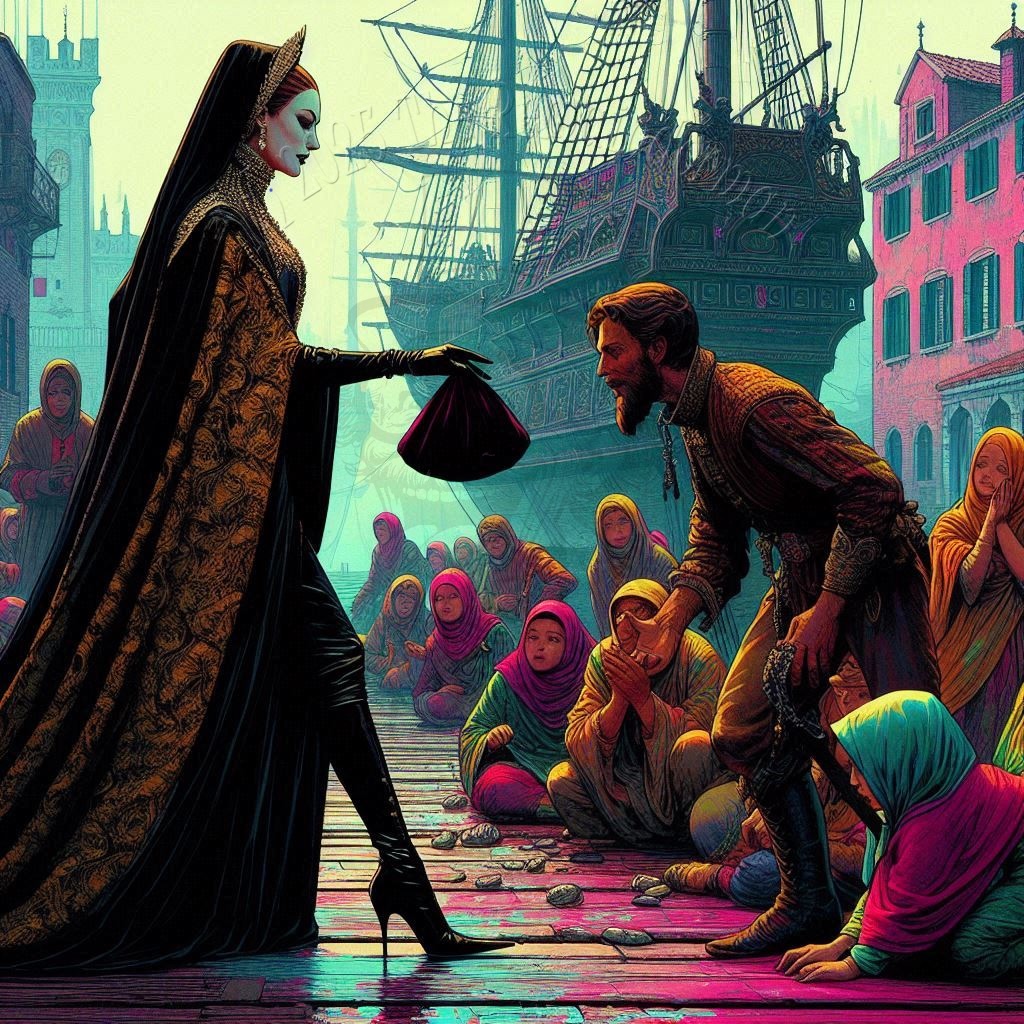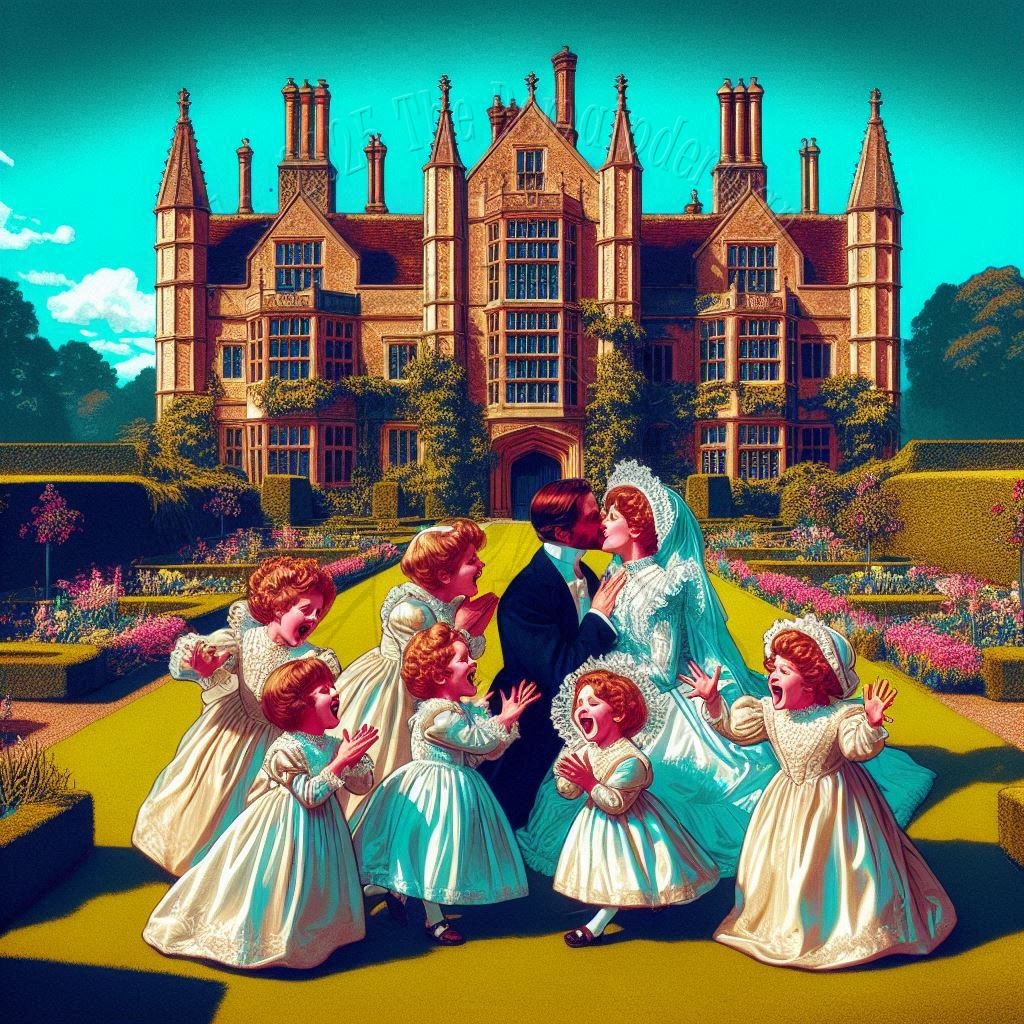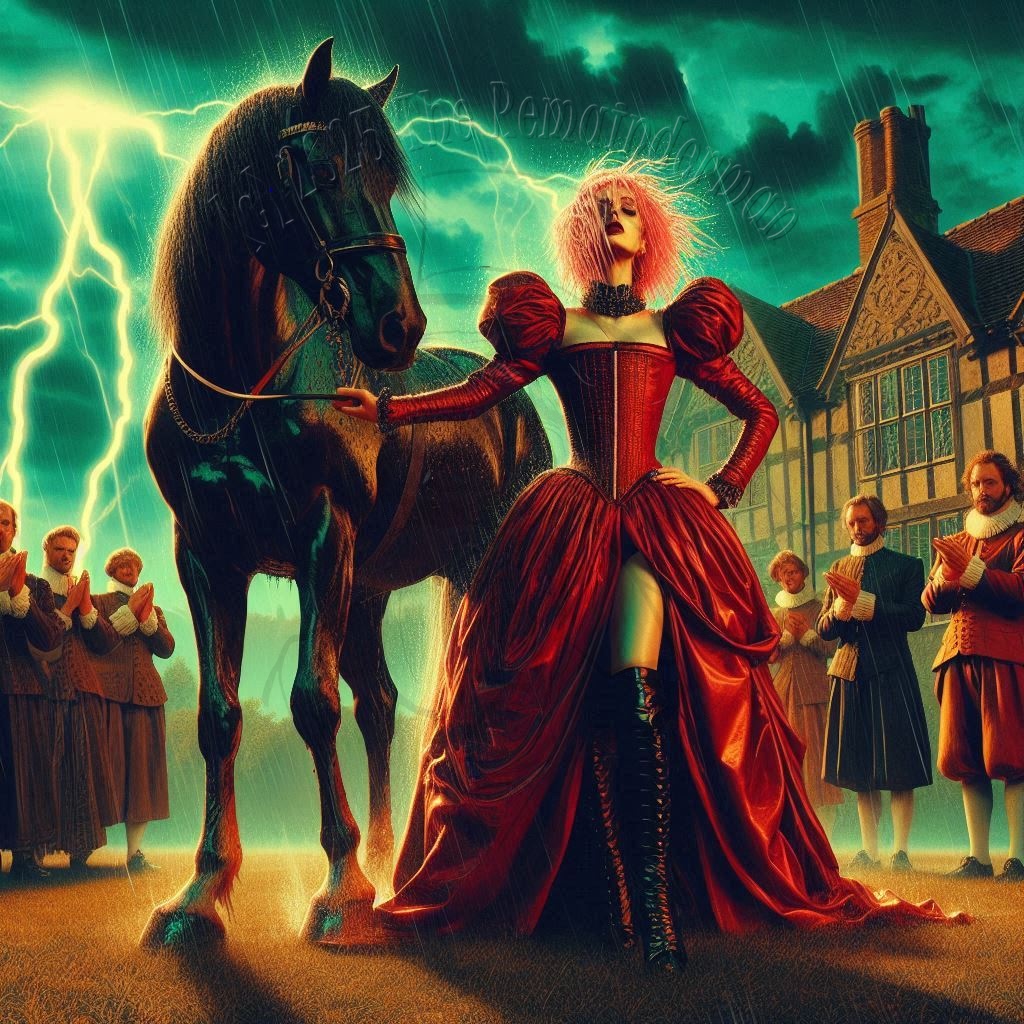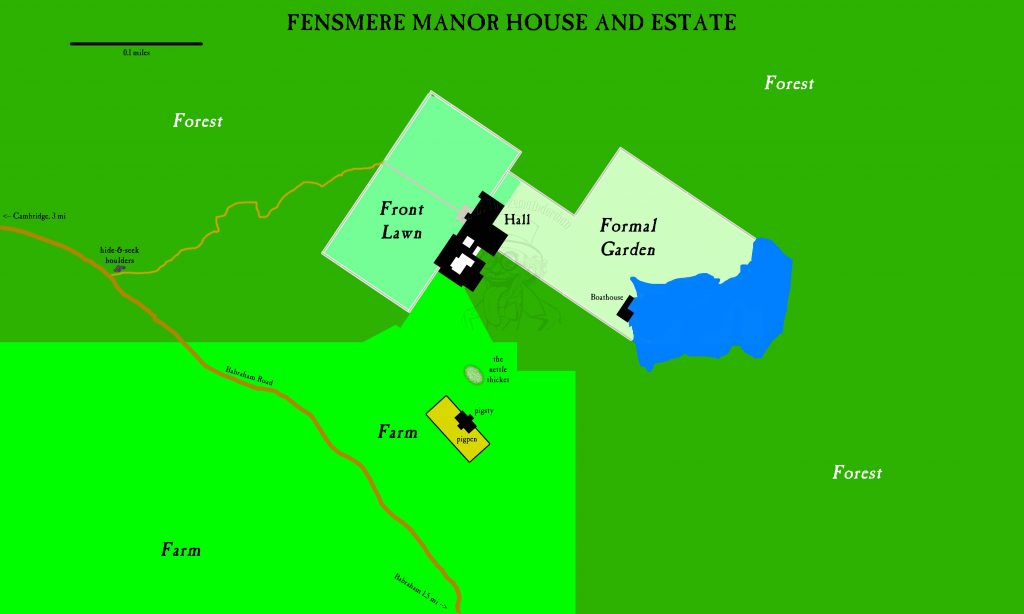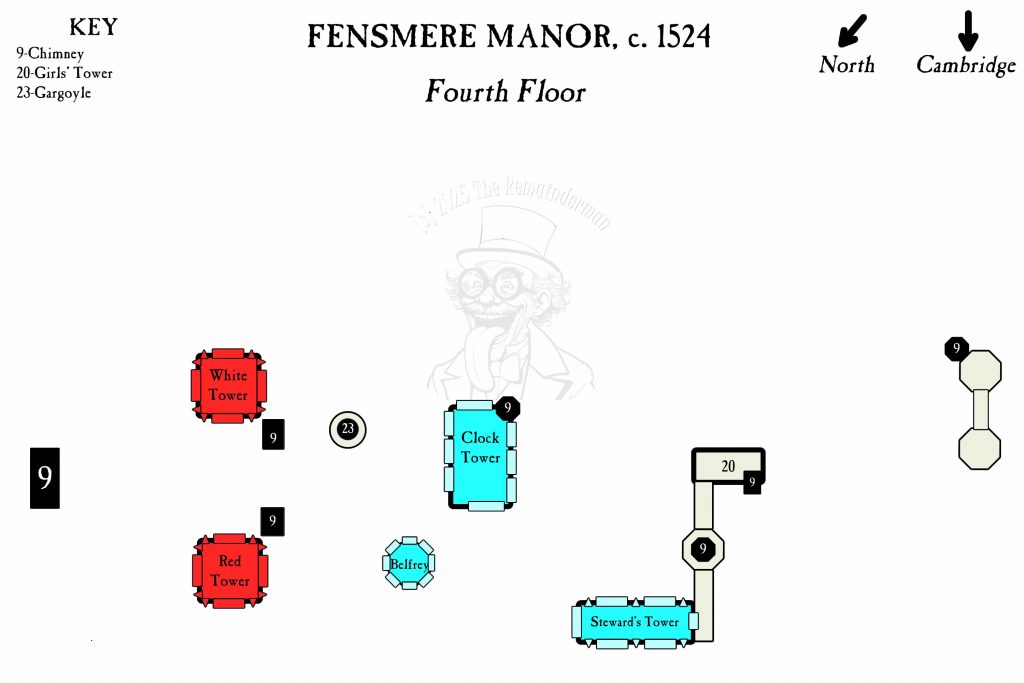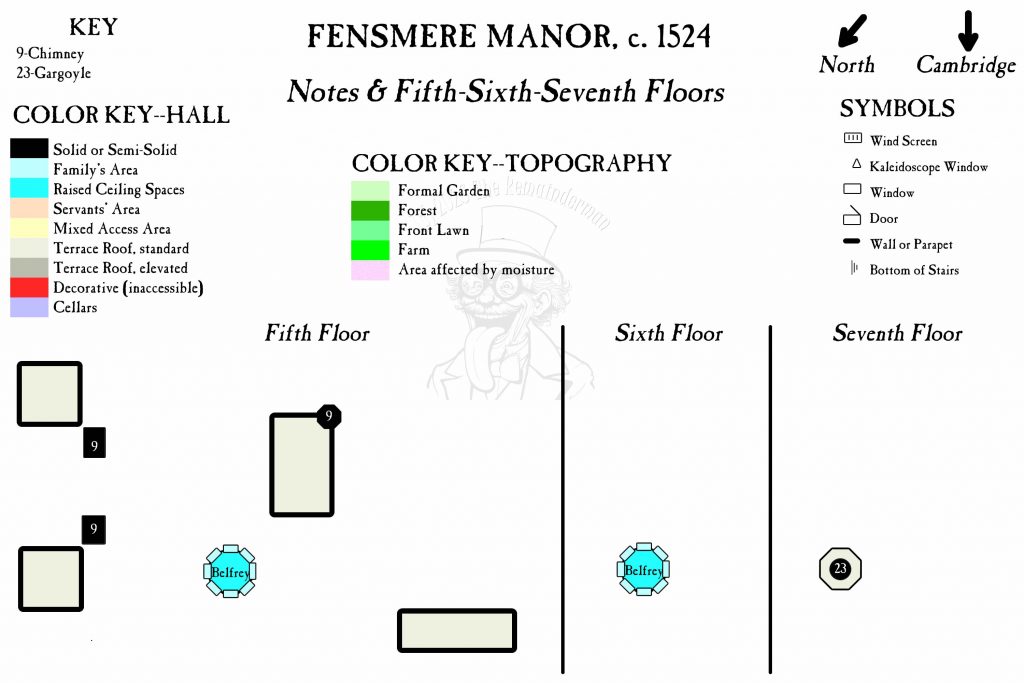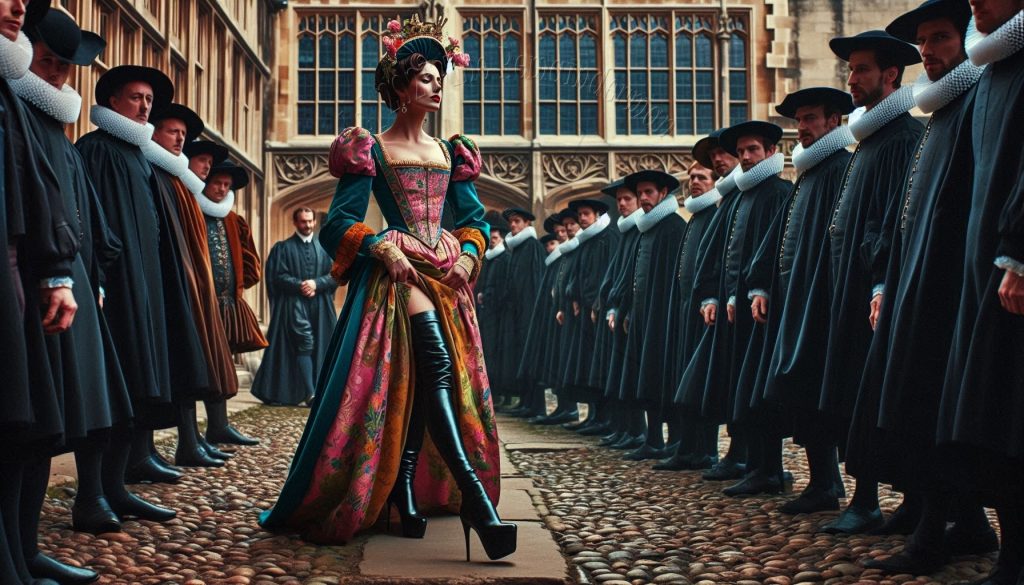
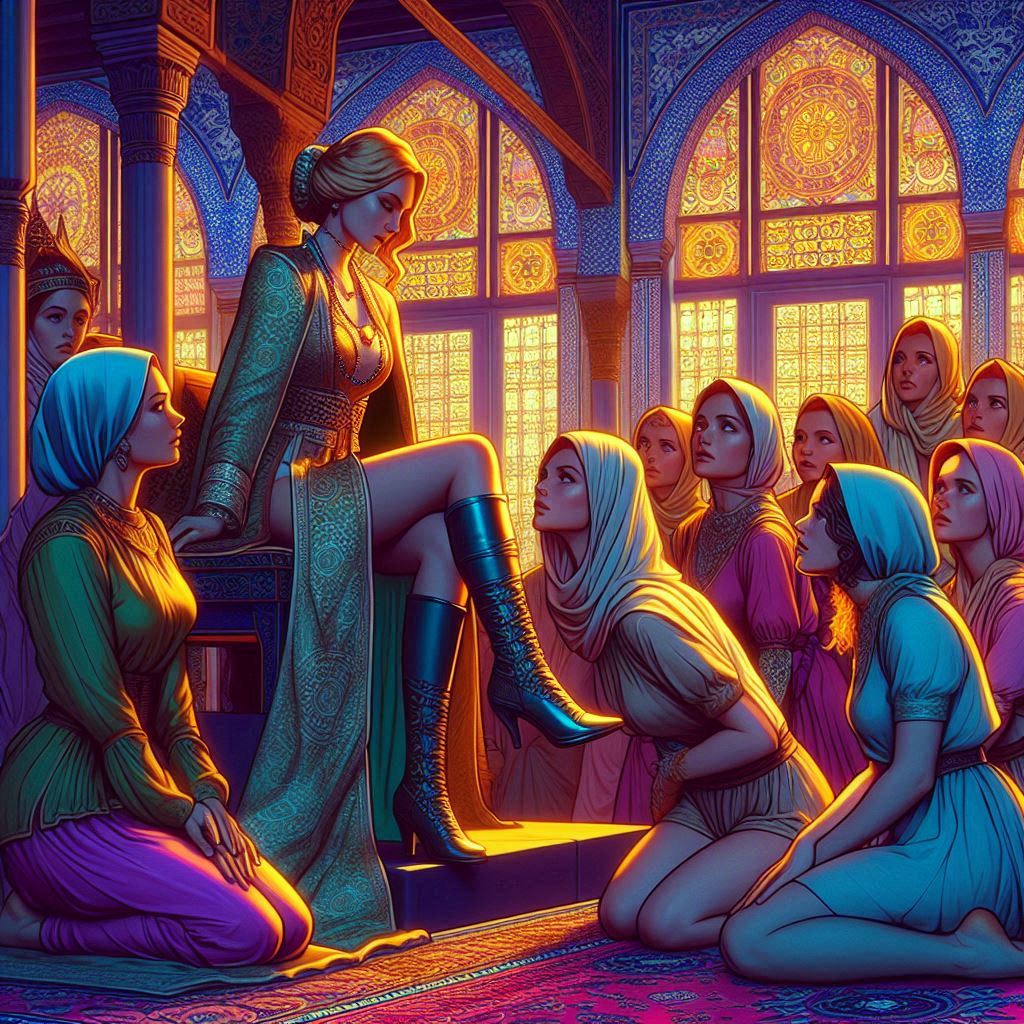

EXPLICIT VERSION AVAILABLE AT https://patreon.com/TheRemainderman
continued from 06-42[X]
Her bridegirls, on their knees before Channah’s elevated throne, had together placed a fine silver chain around her left ankle, symbolizing her power over them, from which she hung the magical keys to their Svadishthana Cages, as they watched from inches away.
Smirking, she had then leaned forward and secured her second rings around their necks: their Vishudhha Collars. They appeared to be very similar to one another: thick straps of soft white leather decorated with brass studs, each having a brass heart-shaped slave tag with their full name—Chastity and Penance, respectively—on the front, and the legend “Property of Countess Anne Batonnoir, Fensmere Manor” on the back. Chas’s was slightly wider than Penny’s, while Penny’s had a gold chain decorating its lower edge. At the ceremony itself Channah had laughingly declined to explain what the collars did, cautioning only that if they didn’t obey her, they would regret it. But afterwards, while holding Penny in an uncomfortable and embarrassing position beneath her, she had explained this much:
“The Byzantine Mural is yours. I made it, so it will always tie you to me, but it’s yours, defiled to you as part of our wedding ceremony like the anklet and ring you gave me. And to the rest of the world, it’s cheap cast-iron. The leather collar, like Chas’s, is also yours, with the usual powers. What looks like a gold chain, however, is something altogether different. But you knew that, didn’t you?” He nodded quietly, having seen—and felt—the great sapphire set in the heavy gold collar stretching from the upper part of his neck to the tops of his shoulders. “The Yoke and Star of Bethlehem are mine. They are always connected to me, and always in my consciousness. When I call to them, they call back; and they burn like the sun to me no matter how far away from me they are. So I can always find them, and I will always be able to find you. I am dressing you up in my property like a lord dressing his servants in his livery, or a pet owner dressing their pet. The Yoke is as much my property as you are. I am merely storing it around your neck, little girl, and letting it provide magical shelter to you, the same as my hamper offers you your bed when I send you to it. Do you understand?”
“Ye—yes, Domina,” she answered, nodding earnestly and nervous lest Channah might suddenly pinch or throttle or otherwise assault her with her hands. “I understand. Thank you, Domina, for lending me your shelter.”
“Good answer, girl. This,” she flicked the brass heart engraved with her name, “Cheap brass, is yours. Entertainment. Obviously not a part of my masterpiece. Like the mural, like all my magic, my collar conceals itself to all but my courtiers. But by my command, the secrecy of the collar goes further. It can only be seen for what it is, by the five of us: me, my two most loyal Duchesses Miryam and Rivqah, the metalsmith who forged it, and you—the person who has the most to lose by revealing its existence to anyone. Others will see it as just another service collar, when they expect to see you collared—probably, when I or one of my servants has you on a leash. And they will see it as a girl’s choker, or even a tight necklace, when they don’t expect you to be collared. Fortunately, your neck is feminine enough there’s no need for it to cover your Adam’s Apple, so I don’t need to worry about that.
“The Yoke will not protect you, or any part of you, from harm by misadventure. You can be hurt or killed like anyone else. If someone outside my Court, or even outside the five of us, were to learn about it or get the idea whatever they see around your neck is valuable, say, from you—can you imagine how quickly they would turn on you for the most-precious stone in Christendom?” She smiled with satisfaction, seeing she had understood the moment she was collared. “And like your chastity, it can’t be removed by natural means or by other people. Only supernatural means, by me.” She shrugged. “Or, since it doesn’t protect you, of course, by anyone on the planet willing to saw your head off. So, I think you understand how very, very vital it is that no one ever get any idea of what you’re wearing?” He nodded urgently, but silently. “Good. If I were you, I would also stay very close to my protectress. The one person powerful enough to protect you if word of what’s around your neck were to get out. The one person who can remove the collar without removing your head, and who actually finds you useful enough to lend her collar to.”
“Yes, Domina, thank you, Domina,” he dared to answer.
“It will prevent aging, and provide you safety from disease, infirmity, and the ravage of time, for as long as you’re useful enough to me to let you keep it. Meaning your clean, tight, hairless skin will remain as vibrant and beautiful in a dozen years, even a hundred if you’re useful enough to me that I want to keep you in it that long, instead of moving it to a more-useful courtier. Meaning you can remain as part of my court on Earth, as long my Ladies’ Maids. Even as long as me. IF you make sure to remain useful. IF you apply yourself to every task I set you, for me. IF you use your skills to serve my court.” She snickered. “So naïve, I can see you’re still as angry with me as you are fearful. Doubtless you’re telling yourself you’d rather be free than immortal. But I’m patient. Sometime—not long from now, even in human terms—you’ll find you’ve become accustomed to the idea of living forever, even as a eunuch who suffers for his Domina. And you won’t ever want to take it off. I know you’ll want to remove the Byzantine Mural—of course, who wouldn’t? But not this. Eventually, you’ll do whatever I say to keep it on. Eventually, you’ll do whatever it takes, no matter how repugnant or vile the task, to keep it. Eventually, my Court and the other denizens of hell will be your only peers, because you will have outlived everyone and everything you know in this world.” He shivered involuntarily at the thought. “And then, little girl, you will be my perfect little pawn. Allll mine.”
In exchange for her collars marking them to the world as her owned wives, the girls had knelt before her again and each given her a silver ring—actually a fine chain, soft and accommodating as they were expected to be—and placed it on a toe of their Domina’s left foot, symbolizing her superiority to them.
Their third exchange was in some ways the most intimate: As they continued kneeling before her, heads bowed, each of them offered her a tiny silver-mesh globe like a miniature tea-infuser, as she cut a lock of each of their hair, enclosing it in the silver-mesh globe and hanging each girl’s egg from her waist chain, where they joined 34 others, each given to her by a previous sisterwife, and each of which, by giving her a part of their flesh, gave her the power to ensorcell them at any time or distance. In exchange, she presented them with their Muladhara Twisters, or Intimates: the special tools of behavior- and body-modification unique to them, that only she or—with her permission, as part of their play group—her friends would ever use on them, and that would only ever be used on each of them. The first was a long, wicked, black wooden paddle, the black sticks upon which she had based their human surname. Chas’s was engraved, “Chastity’s Lover Boy,” and Penny’s “Penance’s Bull Daddy,” prompting a round of guffaws and jeering comments from the assembled succubae, incubi, damned, and operatives watching the proceedings. She also produced mysterious, elongated, jewel-encrusted gold ornaments—Chas’s diamond-studded, Penny’s ruby-studded.
For the breaking phase, rather than breaking a glass, while the girls were held down on the floor, Channah trampled them. When Penny passed out from the pain, Channah rolled her eyes with a snort of disgust and sent her bridegirls to bed—that bed being her dirty-clothing hamper, which had to be forced closed by the men who escorted them there, for it be latched shut with the two of them crammed in it on top of her dirty laundry.
Channah and her Court then celebrated together all night long. The next morning, and for most of the remaining two days and nights of the hazing, Channah put her housegifts through the Seven Indignities. These began by familiarizing them quite intimately with their Intimates as she gave each girl a paddling.
By the end, she had reduced them to the most pathetic kinds of broken, simpering sissy sisterwives. And the Star and Yoke of Bethlehem had begun to manifest their power, with intended and side effects alike. Not the least of which, Channah suspected, was how it had permitted her to really feel, for the first time, the submissive joy of releasing all control. And which she blamed for gentle Penny’s sudden, shocking, and thoroughly discombobulating outburst from his knees before her, in the final moments of their ceremony, that he loved her.
PART 6 OF STORY RECAP
Literature Section “06-43[X] Grimm Transformations VI: Sexual Sorcery”—Accompanying Images: 1532-1534. Abridged 1593 words::Explicit 1917 words—©2025 The Remainderman. This is a work of fiction, not a book of suggestions. It’s filled with fantasies, idiots, and criminals. Don’t believe them or imitate them.





